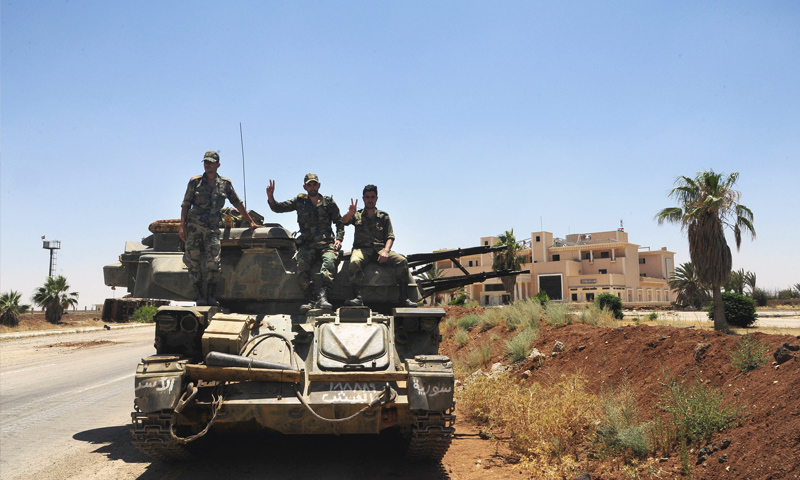Troops under Assad’s forces were redeployed on the borders with occupied Golan Heights after the implementation of the settlement agreement with the opposition factions.
On Wednesday, August 1, the “Central Military Media” Network reported that Assad’s forces had been deployed in Jubata al-Khashab, Aufania, and al-Huria villages in the northern countryside of Qunietra, under an agreement signed with the opposition factions.
They also entered the “strategic” al-Hamriyah hilltop, to the south of the village of Hader in the northern rural parts, which the opposition factions were in control of since 2016.
The last batch of Quneitra’s displaced people has arrived at Idlib governorate a few hours ago, including 1893 people, and it was preceded by other patches of 5400 persons.
Simultaneously with the deployment of Assad forces on the borders of Golan, the Russian ambassador in Tel Aviv Anatoly Viktorov has assured Israel that the control of the borders will be done only by Assad’s forces, and no foreign forces, particularly Iranian and allied militias, will be present there.
Yesterday, (Tuesday) July 31, he told the Israeli “Channel Ten” that an agreement has been sealed, which prevent the deployment of troops on the Syrian side of the borders other than Assad’s forces, pointing out that “the priority is insuring Israel’s security, and that this is not mere words when it comes to the Russian foreign policy.”
Israel has been occupying Golan Heights since 1967, and the Syrian forces are not allowed to enter the area of separation due to the 1973 ceasefire deal.
The Syrian regime, in the past a few years, has repeatedly accused Israel of supporting the opposition factions at the borders of occupied Golan and running their battles inside Syria, especially in rural Quneitra and adjacent areas.
Quneitra has always been of a high sensitivity if compared to the rest of the areas in southern Syria, for being adjacent to Golan Heights occupied by Israel.
According to Quneitra deal, “Brigade90” and “Brigade61,” affiliated with Assad’s forces are to enter the ceasefire line and the demilitarized zone according to the 1974 deal, accompanied by the Russian police. The admission mechanism and coordination are the responsibility of the negotiations delegation in the southern and northern sectors.
The agreement also provides for the formation of a committee to follow up on the detainees’ cause and to guarantee freedom of opinion and expression under the law.
Following the departure of the buses, boarded by fighters and those who refused the reconciliation agreement to Idlib, the UN supervision point in the town of Umm Batnah will be surrendered and the Russian police will enter the UN point in the town of Rwihinah.
These terms are the deal’s first stage and the second stage will be agreed upon after the above-mentioned terms are implemented.
The deal has also provided for the establishment of a three stripes buffer zone, 80 kilometers; the first sector is 10 kilometers wide, an area of 235 square meters, extending on the Syrian territories of the Golan borders. In this sector, “UNDOF” and the Russian military police will be positioned to conduct supervision.
In the second sector, Assad’s forces will position 350 tanks and three thousand troops with light arms. The third sector will be a place for 650 tanks and 4500 troops with light arms, in addition to a limited number of canons of a specific range that do not exceeded the first phase.











